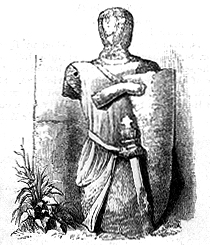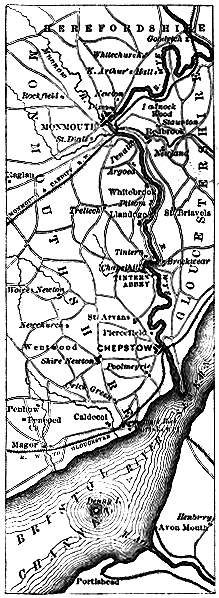Effigy of De Bigod
The Valley of the Wye
|
Irish oak once covered it, with a cupola in the centre, rich with stained glass; and you may see up there the stone corbel heads, with grim carved faces, on which it rested for twenty years after the castle surrendered to Cromwell. Where once hung the gallery of the musicians, now yawns, high up in the wall, the doorway through which long ago they all passed into the shades.
Mounting the grand staircase, whose broad entrance invites me (and whose like I know of in no other Welsh castle), I quickly reach the open air at the top of the ivy-covered wall. From this height we look abroad upon a lovely landscape reaching away to the mountains beyond Abergavenny, and including villages, fields, forests, churches, repeated again and again over miles of fair distance.
A moat with water in it is not a thing to be passed lightly by. I descend from the top of the donjon keep, cross the modern rustic bridge which spans the moat, and seating myself on a stone against the ivied wall there, linger long in reflection in this Weird, romantic, beautiful spot. Nobody comes here to disturb my reveries; the silence remains utterly unbroken; the merry-makers of the fête are gathered on the green far from here, and not a sound of its brass-band is able to penetrate to me through the half dozen or more solid walls whose accumulated feet make a barrier that would muffle the noise of the Boston Jubilee were it next door. I am really in the moat now, though the waters of the moat lie far below me in a still deeper fosse. A broad sunken walk runs almost completely around the donjon keep. Behind me, perhaps a dozen feet above my head, rises a stone all thickly overgrown with ivy. At the top of the wall is the level lawn of the terrace in front of the grand portal. Below me sleep the waters of the moat, with great lily leaves afloat on their bosom. A flight of stone stairs (broken in places, and protected with a stout wooden hand-rail) leads out of the moat up into the pitched stone court we first entered.
|
|
At its foot is a dark archway leading to a range of vaults under the gate towers. To my left runs the sunken Promenade in which I am sitting, shadowed by its high wall; and at frequent intervals I observe deep niches in this wall, ten feet high, which are empty and moss-grown now, but in the days of the castle’s glory they were occupied by the effigies of Roman emperors that stared stonily down upon the water throughout many centuries.
|



